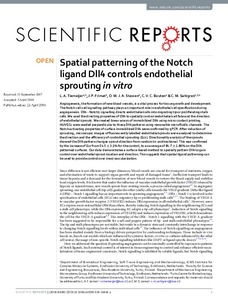Spatial patterning of the Notch ligand Dll4 controls endothelial sprouting in vitro
Tiemeijer LA; Frimat JP; Stassen OMJA; Bouten CVC; Sahlgren CM
Spatial patterning of the Notch ligand Dll4 controls endothelial sprouting in vitro
Tiemeijer LA
Frimat JP
Stassen OMJA
Bouten CVC
Sahlgren CM
NATURE PUBLISHING GROUP
Julkaisun pysyvä osoite on:
https://urn.fi/URN:NBN:fi-fe2021042825781
https://urn.fi/URN:NBN:fi-fe2021042825781
Tiivistelmä
Angiogenesis, the formation of new blood vessels, is a vital process for tissue growth and development. The Notch cell-cell signalling pathway plays an important role in endothelial cell specification during angiogenesis. Dll4 - Notch1 signalling directs endothelial cells into migrating tip or proliferating stalk cells. We used the directing properties of Dll4 to spatially control endothelial cell fate and the direction of endothelial sprouts. We created linear arrays of immobilized Dll4 using micro contact printing. HUVECs were seeded perpendicular to these Dll4 patterns using removable microfluidic channels. The Notch activating properties of surface immobilized Dll4 were confirmed by qPCR. After induction of sprouting, microscopic images of fluorescently labelled endothelial sprouts were analysed to determine the direction and the efficiency of controlled sprouting (Ecs). Directionality analysis of the sprouts showed the Dll4 pattern changes sprout direction from random to unidirectional. This was confirmed by the increase of Ecs from 54.5 +/- 3.1% for the control, to an average of 84.7 +/- 1.86% on the Dll4 patterned surfaces. Our data demonstrates a surface-based method to spatially pattern Dll4 to gain control over endothelial sprout location and direction. This suggests that spatial ligand patterning can be used to provide control over (neo) vascularization.
Kokoelmat
- Rinnakkaistallenteet [27094]
